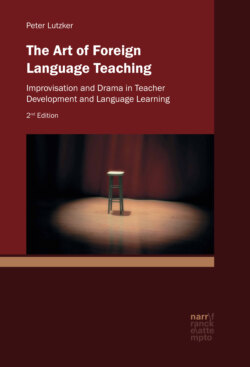Читать книгу The Art of Foreign Language Teaching - Peter Lutzker - Страница 63
На сайте Литреса книга снята с продажи.
6.3.1 Games of Imitation and Mirroring
ОглавлениеThe first games usually involve different forms of imitation. The game ‘Simultaneous Leader’ requires a group of four people facing one another to simultaneously imitate each other’s gestures and sounds. There should be no clear leader, but rather the role of the ‘impulse giver’ should be equally shared by everyone. Thus, the continual changing back and forth between self-initiated activities and imitating another requires a high degree of concentration and observation. Trying to achieve the highest level of synchronicity of movement and sound while at the same time trying to maintain an equality of ‘leadership’ between the members of the group creates an intense awareness of what is happening in those moments, generally precluding conscious filtering, judging or even thinking. At a later stage of the game one group may go out and ‘encounter’ another group – each group still imitating each other while reacting at the same time to the others, thus adding significantly to the complexity of the task. (The results are generally very humorous!)
For Gladwell, the process of imitation is a fundamental human capability:
There is something fundamental about imitation that I still find very mysterious. Imitation practices empathy. I believe imitation also tells us something important about how we negotiate our identity in the world. I believe we exist in resonance with others around us. We only truly become ourselves when we are able to become like others. Our ability to become other people makes us better at being ourselves. (Interview 2)
There is no doubt that the imitative capabilities of children are the basis of essential social and developmental processes. However, for adults to re-enter fully into this process of imitation often requires making a step into a now unfamiliar territory. During this process behaviour is no longer governed by the conscious mind, but is dependent solely on seeing, listening and unconsciously following:
As adults we learn to withdraw and hold back how we act in the world which is a good idea if you don’t want to get into trouble. But imitation invites you just to mirror the other and not to judge or filter. You move out of the head into doing. This capacity to imitate practices seeing the world from the other’s point of view. You get to experience the world as the other experiences it and not through your intellectual understanding of the other’s experience. Clowning invites you to see the world through empathy and not through understanding. (Interview 2)
At first glance it might appear that the capacity for imitation would not be a decisive element in the context of a workshop on improvisation. However, in Gladwell’s understanding of the different possibilities and qualities inherent in imitation, it becomes evident that there are deep connections between these processes. Just as the child’s imitation is never superficial or mechanical, but a complete and unconscious ‘going with’ the other, the adult also has the possibility of trying to replicate the entire movements, emotions and breathing of someone else. It is not just about doing what the other is doing, but about being alive to the richness of the other. The continual back and forth of leading and imitating in the group demands a heightened awareness and sensitivity to the moment. The sense of presence which this requires is the most essential element in all improvisational work:
In imitation you are constantly struggling between two polarities. On the one hand you have the rule, i.e. you have to imitate and repeat what others are doing. On the other hand, you need to find your way of being alive and present in that structure. That calls for transformation, for change, for evolution. If you just copy what the other is doing and are not somehow living through the form then the games dies. (…) The stated aim of the imitation game should not blind you from seeing that there are differences and transformations; that is what brings life and presence to the game. (Interview 3)
Unsurprisingly, the exercise (Simultaneous Leader) works better for some participants and for some groups than for others. In the short feedback exchanges afterwards, sometimes people say that they felt that they were not being heard or seen by the others and that all they did was imitate. Another problem that can occur in this exercise is that the imitation can become mechanical and lose energy and interest:
One of the big problems you come up against with imitation is when a group goes into a rhythmical pattern. Rhythm and repetition is great as long as you remain present and alive in the structure. The problems start when you are not listening for transformation and change. With rhythm, you could easily be misled into thinking that what happened before, will be what happens after. That is what repetition is by definition. But it never is – not in this game anyway. And when you start thinking you know what will happen next, you stop listening to what is happening now. (Interview 3)
This distinction between organic imitation and mechanical imitation is something which is not only experienced by the members of the group, but is also quite visible for an observer.
